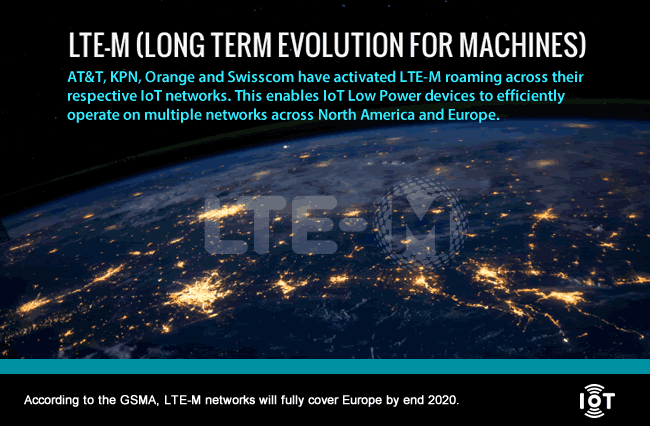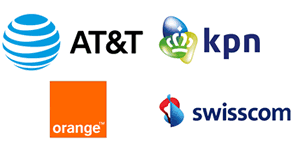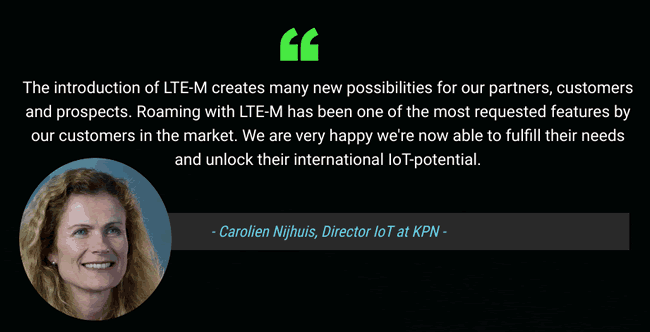KPN, Orange, Swisscom and AT&T have activated LTE-M roaming. LTE-M or ‘Long Term Evolution for Machines’ is a cellular low-power wide-area network (LPWAN) technology and standard for Internet of Things (IoT) applications.
In 2019 AT&T and Vodafone Netherlands already announced an LTE-M roaming agreement, promising to open up their networks by the end of the year. An overview of the first markets this covers and why LTE-M roaming is important with additional details on the strategies of operators for cellular IoT connectivity.
Thanks to LTE-M roaming, LTE-M IoT devices can operate across the different networks of operators. Customers are asking for LTE-M roaming and for operators offering LTE-M roaming there’s obviously a competitive – temporary – advantage as they have an additional argument in the shape of the broader network capability as such with room to increase revenue and an impact on use cases for which they can provide support. LPWAN is the fastest growing category of IoT connectivity (also in Industrial IoT and applications requiring wireless IoT connectivity across several Industry 4.0 use cases).
LTE-M roaming agreements make it easier for businesses around the world to benefit from the power of a globalized IoT (John Wojewoda, AVP, Global Connections Management, AT&T)
Cellular standards LTE-M and NB-IoT are forecasted to overtake non-cellular protocols somewhere around 2023 and take the lead in the wireless IoT landscape of wide area networks. Mobile operators started deploying LPWA networks using cellular technology a few years ago as the cellular mobile market essentially needed to catch up with pioneers offering LPWAN in the unlicensed band (non-cellular) and was able to start doing so after standards organization 3GPP’s release 13 (many operators offer non-cellular options too).
Four telcos, AT&T, KPN, Orange and Swisscom have activated LTE-M roaming across their respective IoT networks, enabling LTE-M devices to operate on multiple networks across North America and Europe.

LTE-M roaming: the start as LTE-M networks continue to be rolled out
A few words on LTE-M before looking at the LTE-M roaming partners. LTE-M networks (also still called eMTC, Cat-M and LTE Cat M1) were initially mainly launched in North America, among others by AT&T.
LTE-M is the most powerful of the LPWAN standards and, among others, supports mobility which has an impact on the use cases it’s best suited for. The latency of LTE-M is also lower than that of the other, for now more popular and largely available 3GPP LPWAN standard, NB-IoT which further narrows down the use cases it’s best fit for (LTE-M has 10 to 15 milliseconds delay).
More operators and countries will join the LTE-M roaming agreement. According to the GSMA, LTE-M networks will fully cover Europe by end 2020.
Customers of US operators wanted NB-IoT, let’s say the ‘lighter’ cellular LPWAN standard fit for other use cases and circumstances, that’s a more direct answer of the mobile industry to the likes of LoRaWAN and Sigfox, the best-known of those mentioned pioneering standards/players. So, in North America NB-IoT networks now have been or are rolled out. In Europe – in general – it’s the opposite: NB-IoT came first and LTE-M next.
With more LTE-M networks available time to activate LTE-M roaming has come. The four mentioned operators expect to be able to add more parties to these roaming agreements in the coming months as LTE-M keeps being rolled out.
According to the GSMA, LTE-M networks will cover the whole of Europe by the end of 2020. That is still to be seen, however. When commercial roaming agreements have expanded the market for LTE-M devices and applications should expand given the disappearance of all the hassle in dealing with many carriers and all the logistical consequences. There also have been several NB-IoT roaming trials with more planned for 2019. Time for a look at the four operators in the LTE-M roaming agreement.
The LPWA network strategies of the four LTE-M roaming partners and more LTE-M network plans
AT&T rolled out an LTE-M network in the United States and Mexico relatively early. Yet, just as its competitors also had to go for NB-IoT.
AT&T announced the availability of its NB-IoT network in the US end May 2019 and, thus, now offers both.

KPN launched LTE-M throughout the Netherlands. KPN was among the first to offer nation-wide LTE-M coverage in Europe. The availability of its LTE-M network was announced in March 2018. Among the reasons why KPN picked LTE-M first is the fact it was the first in Europe to offer nation-wide LoRaWAN coverage and it still offers the non-cellular LPWA network option.
Orange’s LTE-M network is available in France and Romania with Belgium, Slovakia, Spain and Poland following later this year the announcement of the LTE-M roaming agreement says. However, Orange announced the launch of its nationwide LTE-M network in Spain on the same day as the roaming was announced.
We reported on the choice for LTE-M and NB-IoT by Orange in Belgium before and interviewed the company’s partner AllThingsTalk who is working with more operators preparing their LTE-M networks (and thus potentially joining the LTE-M roaming agreement later). Orange went for NB-IoT and LTE-M in Belgium as its main competitor already had LoRaWAN (in other countries, including France, Orange offers LoRaWAN and LTE-M).
Swisscom finally has LTE-M coverage in its Swiss home market (and also offers NB-IoT). Several large European countries aren’t covered in the LTE-M roaming agreement yet but, as said, this will change. In Germany, Telefónica Deutschland launched its NB-IoT and LTE-M networks early 2019 and Deutsche Telekom should have LTE-M this year too. Vodafone, T-Mobile and Deutsche Telekom are among those preparing more LTE-M networks across Europe.
Where LTE-M fits according the roaming partners
In announcing the LTE-M roaming activation, KPN, Orange, Swisscom and AT&T remind that LTE-M enables many IoT applications at lower costs with compact IoT modules, a longer battery life and with good coverage in hard-to-reach locations.
This is all true but mainly a message compared to those mobile connectivity options using cellular technology before 3GPP release 13.
LTE-M networks operate within licensed spectrum with carrier-grade security and are perfectly adapted to moving objects.
It’s important to check what standard suits best for your applications. Many use case categories (names for types of applications such as ‘smart metering’, that in reality can mean many things, in the case of smart metering for instance, all sorts of utilities but also consumer-oriented applications as Industrial IoT ones), that are often mentioned for LTE-M can also be served by NB-IoT or non-cellular standards, depending on several factors (it’s not always about the best connectivity, IoT deployments need more).
NB-IoT is a cheaper option than LTE-M for now, it typically offers an even longer battery life (battery life is essential in LPWAN as replacing batteries comes with a cost) and NB-IoT also has good coverage in hard-to-reach locations and for in-door applications (LTE-M penetration is a tad bit better).
The main differences: LTE-M is more powerful, has higher bandwidth, is much better for bi-directional applications (sensing and actuating) with higher downlink and uplink speeds, has far lower latency (important for near real-time applications and more critical ones), supports voice (VoLTE) and, as the operators emphasize at the occasion of the LTE-M roaming announcement, is extremely suitable for moving objects (NB-IoT is a better fit for stationary assets).

The significance of the LTE-M roaming agreement and more information
Some comments from the four telcos in the roaming agreement. AT&T’s John Wojewoda points out that more and more of the company’s business customers are demanding global capabilities as they implement IoT devices and applications.
These LTE-M roaming agreements help to meet that demand. A similar comment from Carolien Nijhuis, director of IoT at KPN who says that the introduction of LTE-M creates many new opportunities for KPN’s partners, customers and prospects and that LTE-M roaming is one of the most requested functionalities of KPN customers.
Orange’s Didier Lelièvre says he’s proud that Orange (that has been investing quite a bit in LTE-M already indeed) is one of the first operators to offer a roaming option to its IoT customers and partners. For him LTE-M roaming is a clear priority for Orange and its’ clients.
Julian Dömer, head of IoT at Swisscom, finally, also states he’s happy that his company has a strong position on roaming and is among the first operators that enhance the key technology LTE-M for 2G replacement with international roaming.
In case you need some guidance on when LTE-M is a better fit talk to your operator and IoT implementation partners. If cellular LPWAN (NB-IoT and LTE-M to be precise here) is what you prefer given, among other possibilities, existing relationships with telcos, QoS or any other reason, the little matrix from a Sierra Wireless infographic (PDF opens) below is handy with parameters being latency (from batch communication to real-time communication needs) and speed. You see the overlap between the use case categories we mentioned in the color codes. Do note this is one view.

You won’t just see more LTE-M roaming agreements but also more LTE-M launches (and NB-IoT) as it all fits in the road towards 5G as well, which is another story.
The GSMA keeps track of commercial roll-outs of LTE-M and NB-IoT (with some delay) in case your country wasn’t mentioned in the countries covered by the LTE-M roaming agreement announcement and you want to find out if it already has LTE-M.
Update: end October 2019, AT&T and Vodafone Business also announced an NB-IoT roaming agreement covering the US and five European countries, also available by the end of 2019.
LTE-M FAQ
LTE-M is a cellular low-power wide-area network (LPWAN) standard for Internet of Things applications. LTE-M stands for Long Term Evolution for Machines or LTE-MTC. There are three cellular LPWAN standards: LTE-M, NB-IoT and EC-GSM-IoT.
Both LTE-M and NB-IoT are cellular LPWAN standards. In the US, LTE-M networks were deployed first; in Europe, NB-IoT networks were deployed first. LTE-M, a stripped-down version of LTE:
Is more powerful than NB-IoT.
Has lower latency than NB-IoT.
Supports voice (VoLTE).
Is better suited for mobile use cases as it supports full mobility.
Has a higher bandwidth than NB-IoT and any other LPWA technology.
The data transfer of LTE-M can go up to 1 Mbps in both directions (uplink and downlink), depending on how it is used (for instance, full-duplex), the operator and the local situation.

